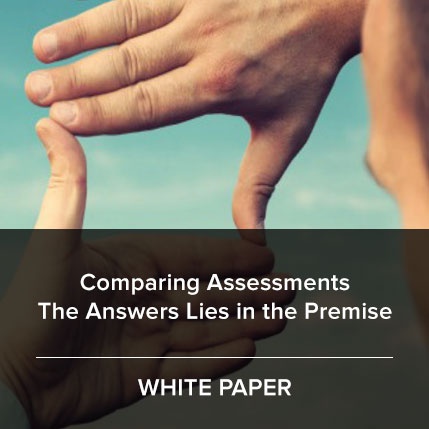Whether you’re working in-house with internal employees or at a consulting firm with external clients, employee assessments—of one kind or another—are probably part of your toolkit.
But when was the last time you assessed those assessments? Are they the right tools for the job? And are they delivering the ROI you need?
Here are 4 signs it might be time to invest in better employee assessment tools.
- People can’t remember their results.
We’re living in a complex world; we need robust tools to deal with that complexity. But that doesn’t mean overly complicated, difficult-to-implement or impossible-to-remember is better when it comes to employee assessments. If the formula is so complex or esoteric that people can’t remember what they’ve learned, then what was the point.
A better option: Look for balance. The best assessments are grounded in a robust, proven methodology but presented in a simple, memorable way that people will instantly understand, remember and apply to their daily workplace realities. And remember that one size doesn’t fit all. The models and results that can be described in a variety of different ways will engage the most people and have the broadest impact.
- People are feeling pigeonholed or limited by the experience.
Pigeonholing is an obvious downside of an assessment that puts people into tight categories. If the design leads to stereotyping, you’ll likely end up with morale, engagement and performance issues.
But there’s another side effect of typecasting that isn’t always as apparent on the surface: When an assessment shows limits rather than possibilities, it removes personal accountability. It tells the person there’s nothing they can do to stretch or change, so why bother?
A better option: Look for assessments that not only raise self-awareness but also show the potential and possibilities to expand beyond preconceived limits. When people understand that they’re personally accountable and have the ability to stretch, there are no cop-outs.
- No one’s using the information, or you’re just not seeing a business benefit.
One of the reasons companies run into trouble linking assessments to business issues and outcomes is that the instruments they’re using weren’t originally designed to be used in business settings. As a result, the tools are being shoehorned into a situation they weren’t intended for. They may quickly raise awareness or impart some knowledge, but they’ll often fail to make a tangible business impact.
Ultimately, this means more work for you—trying to make the connection to business application and bottom-line results—and less value to employees, who, in an increasingly fast-paced, ever-changing world, need to get to application fast so they can start using what they’ve learned across a broad range of business areas.
A better option: Raising awareness is a good first step, but especially when you’re looking for business results, assessments that have been designed for business will get you there faster. For even more impact and scale, choose those that go beyond individual use to relevant business applications like pairs and teams, and even processes, cultural issues, markets, products and customers.
- Validation is questionable…or non-existent.
Is it really nothing more than a dressed-up Buzzfeed quiz? With the proliferation of tools now available, from free online quizzes to scientific-sounding assessments cashing in on the latest learning trends and fads, it pays to be choosy.
While self-service learning appeals to those employees who are looking for quick fixes on their own time, many of these free or inexpensive (and some not-so-inexpensive) assessments are built on shaky ground at best. Don't assume that just because it’s popular, familiar or sounds legit that it’s a validated assessment; many are not.
A better option: Know who and what you’re working with. To get the best results and maintain your credibility, validation is critical. Key areas of validation to look for include test/retest reliability, face validity and internal construct reliability.
Choose Assessments That Deliver ROI
Employee assessments are great tools to support a variety of talent management, learning and development, and HR needs. Just make sure the ones you choose offer a positive, business-focused experience, that they encourage personal accountability and quick application, and that they’re standing on a foundation of solid research. It’s the best way to get the ROI you, the organization, and your employees and clients are looking for.
If you’re comparing assessments or not getting business impact from your current one, check out this post for additional tips and criteria to consider in your research.










